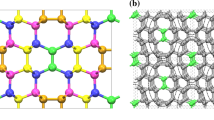Abstract
The search for carbon allotropes with exotic electrical and mechanical properties is one of frontier topics in materials science. In this work, we proposed a carbon allotrope, namely moC12, with unexpected one-dimensional metallicity, superconductivity and mechanical anisotropy via first-principles calculations. This novel carbon allotrope contains 12 atoms in its unit cell with interatomic connections via sp2–sp3 hybridization, forming a three-dimensional spatial sandwich panel anisotropic structure. The dynamic and mechanical stability of the new structure in the ambient state is demonstrated. The one-dimensional conductivity originates from the one-dimensional conductive channel constituted between the sp2-hybridized atoms, while in other directions this conductive channel is interrupted by the residual sp3-hybridized carbon atoms. Moreover, moC12 is superconductive, with a superconducting critical temperature of 2.14 K. The unique three-dimensional spatial sandwich panel anisotropic structure endows moC12 with excellent toughness and also exhibits intense mechanical anisotropy including elasticity and tensile stress–strain. The distinctive conductive and mechanical natures make moC12 a potential material for probe in the direction measuring.







Similar content being viewed by others
Data availability
The data that support the findings of this study are available within the article.
References
Kroto HW et al (1985) Nature 318:162
Iijima S (1991) Nature 354:56
Novoselov KS et al (2004) Science 306:666
Bundy FP et al (1955) Nature 176:51
Bernal JD, Bragg WL (1924) Proceedings of the royal society of london. Ser A Contain Papers Math Phys Char 106:749
Terrones H et al (2000) Phys Rev Lett 84:1716
Liu Y et al (2018) Carbon 126:601
Zhao C-X et al (2019) Comput Mater Sci 160:115
Xia K et al (2022) Inorg Chem 61:18229
Zhang W et al (2020) New J Chem 44:19789
Zhang W et al (2020) Diam Relat Mater 109:108063
Wu X et al (2017) Carbon 123:311
Wang Y et al (2012) Comput Phys Commun 183:2063
Chen M, Ying P, Liu C (2023) Int J Refract Metal Hard Mater 111:106086
Liu C, Liu L, Ying P (2022) J Mater Sci 57:9231. https://doi.org/10.1007/s10853-022-07242-4
Clark SJ et al (2005) Zeitschrift für Kristallographie - Crystalline Materials 220:567
Perdew JP, Zunger A (1981) Phys Rev B 23:5048
Ceperley DM, Alder BJ (1980) Phys Rev Lett 45:566
Heyd J, Scuseria GE, Ernzerhof M (2003) J Chem Phys 118:8207
Pfrommer BG et al (1997) J Comput Phys 131:233
Monkhorst HJ, Pack JD (1976) Phys Rev B 13:5188
Giannozzi P et al (2009) J Phys: Condens Matter 21:395502
Baroni S et al (2001) Rev Mod Phys 73:515
Liao M et al (2020) Comput Mater Sci 172:109289
Occelli F, Loubeyre P, LeToullec R (2003) Nat Mater 2:151
Aasi A, Ebrahimi Bajgani S, Panchapakesan B (2023) AIP Adv 13:025157
Aasi A, Aghaei SM, Panchapakesan B (2023) Int J Comput Mater Sci Eng 2350014
Li Q et al (2009) Phys Rev Lett 102:175506
Wang J-T et al (2014) Sci Rep 4:4339
Zhang S et al (2013) Proc Natl Acad Sci 110:18809
Sheng X-L et al (2011) Phys Rev Lett 106:155703
Rignanese GM, Charlier JC (2008) Phys Rev B 78:125415
Niu C-Y, Wang X-Q, Wang J-T (2014) J Chem Phys 140:054514
Wang Z, Zhu X, Wang M (2020) Solid State Sci 105:106247
Ying P et al (2023) Comput Mater Sci 219:111956
Chen J et al (2021) J Mater Sci 56:17665. https://doi.org/10.1007/s10853-021-06455-3
Wu Z-J et al (2007) Phys Rev B 76:054115
Allen PB, Dynes RC (1975) Phys Rev B 12:905
Chen X-Q et al (2011) Intermetallics 19:1275
Pugh SF (1954) London Edinb Dublin Philos Mag J Sci 45:823
Telling RH et al (2000) Phys Rev Lett 84:5160
Li B, Sun H, Chen C (2014) Nat Commun 5:4965
Acknowledgements
This work was supported by the Postdoctoral Science Preferential Funding of Hebei Province (B2021005001), the National Natural Science Foundation of China (Grant Nos. 52202049, 52103322 and 12064013), the Ganzhou Science and Technology Project (Grant No. 202060) and the Program of Qingjiang Excellent Young Talents, Jiangxi University of Science and Technology.
Author information
Authors and Affiliations
Contributions
PY, YG and CL designed the research. PY, HL and SC performed the calculations. PY, HL, XG, SC, LL, YG and CL analyzed the results. PY wrote the manuscript. All authors contributed to the discussion. PY and HL contributed equally to this work.
Corresponding authors
Ethics declarations
Conflict of interest
The authors have no conflicts to disclose.
Ethical approval
Not applicable.
Additional information
Handling Editor: Ghanshyam Pilania.
Publisher's Note
Springer Nature remains neutral with regard to jurisdictional claims in published maps and institutional affiliations.
Supplementary Information
Below is the link to the electronic supplementary material.
Rights and permissions
Springer Nature or its licensor (e.g. a society or other partner) holds exclusive rights to this article under a publishing agreement with the author(s) or other rightsholder(s); author self-archiving of the accepted manuscript version of this article is solely governed by the terms of such publishing agreement and applicable law.
About this article
Cite this article
Ying, P., Li, H., Guo, X. et al. Prediction of a three-dimensional carbon allotrope moC12 with one-dimensional metallicity, superconductivity and mechanical anisotropy. J Mater Sci 58, 12664–12672 (2023). https://doi.org/10.1007/s10853-023-08767-y
Received:
Accepted:
Published:
Issue Date:
DOI: https://doi.org/10.1007/s10853-023-08767-y




